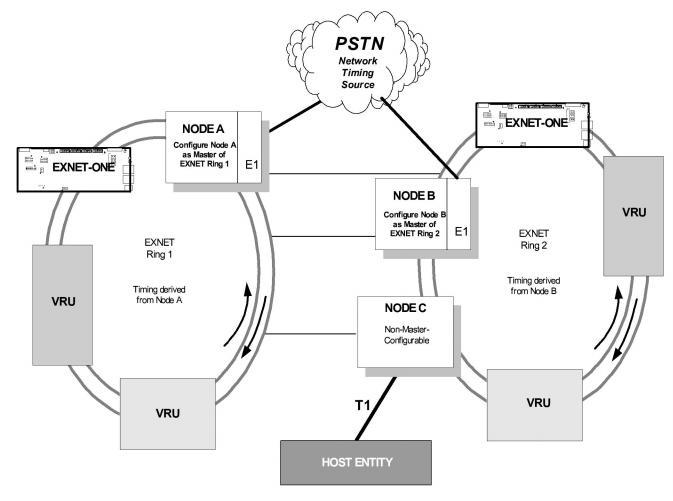
You are here: CSP Developer’s Guide: Overview > 10 Configuring Multi-Node Systems > EXNET Ring Timing

This section explains how to configure the system software for the EXNET Ring Timing Enhancement.
The EXNET Ring Timing Enhancement provides the CSP with following features:
• CSP nodes can select higher quality timing sources.
• CSP nodes can derive loop timing from the EXNET Ring.
• CSP nodes can be configured for each ring, to determine whether they will arbitrate to become the EXNET Ring Master. By default, CSP 1000 and CSP 2000 nodes arbitrate, while EXNET-ONE nodes do not arbitrate.
• CSP nodes can optionally be configured as the master of multiple EXNET Rings.
• CSP nodes can be configured so that if they are configured to derive their loop timing from the EXNET Ring, they will be prevented from arbitrating for EXNET Ring Master.
EXNET Ring Master is the CSP node that supplies timing to the EXNET Ring.
CSP refers to both single and multi-node configurations, and encompasses CSP 2040 and CSP 2090 models.
Master-configurable refers to any CSP node that can serve as the EXNET Ring Master.
Network Synchronization / Prioritizing Clock Source
EXNET Ring Timing Enhancement adds the EXNET Ring as a valid timing source for Loop Timing 1 and Loop Timing 2. The Loop Timing Configure message is used to identify the slot of the EXNET-ONE card.
The CSP continuously monitors all synchronization clock sources and uses the highest priority clock available. The host determines the current clock source from the Current Synchronization Mode byte in the Synchronization Priority List Query message.
When the highest priority source is unavailable, the second highest priority source takes its place, and the Matrix Controller sends a Clock Mode Switched Alarm message. If neither of the reference clock sources are available, the Matrix Controller also sends a Reference Clock Source Lost Alarm. If the higher priority clock source resumes, the Matrix Controller automatically switches back to it, and sends the Clock Mode Switched Alarm to notify the host.
Some network conditions affect how you configure CSP nodes for Ring Timing Enhancement. Consider these conditions before considering the details of timing and arbitration:
• Any CSP node that is to serve as an EXNET Ring Master that provides timing should have a hardware line, which can be T1, E1, J1, or an External Reference Clock.
• The host should configure all CSP nodes that can derive loop timing from the network (PSTN or an External Reference Clock) to do so. These nodes should derive their secondary loop timing from the network as well.
• The host should configure all CSP nodes that cannot derive loop timing from the network to derive their loop timing from the EXNET Ring.
• With redundant EXNET Rings, the host should configure all CSP nodes that cannot derive their loop timing from the network to derive their secondary loop timing from the second EXNET-ONE card.
• The host should configure all CSP nodes to be excluded from artbitrating for EXNET Ring Master if they:
• derive loop timing from an EXNET-ONE card.
• use the Free-running clock.
All CSP nodes that are master-configurable can arbitrate to become the EXNET Ring Master.
In CSP Master Nodes Connected to PSTN providing timing to EXNET Rings, only Nodes A and B can arbitrate to become EXNET Ring Master. They were configured to have a high quality timing source (the PSTN). During EXNET Ring initialization, Node A successfully arbitrated to become EXNET Ring Master for Ring 1, and Node B successfully arbitrated to become EXNET Ring Master for Ring 2. If multiple CSP nodes on a ring are configured to arbitrate to become the EXNET Ring Master, the node that initializes and comes in service first becomes the EXNET Ring Master.
Figure 10-16 CSP Master Nodes Connected to PSTN providing timing to EXNET Rings

When all CSP nodes have received timing from the EXNET Ring Master, EXNET Ring 1 and EXNET Ring 2 serve as the primary clock sources for the EXNET-ONE card and for the Voice Response Units (VRUs) as shown in the diagram.
CSP Ring Timing Enhancement allows all EXNET devices to be master-configurable, although by default they are not master-configurable.
EXNET Ring Timing Enhancement provides some control of the arbitration process with these configuration options:
• You can configure an CSP node as not available to arbitrate to become EXNET Ring Master
• You can allow an CSP node that is already the Master of one EXNET Ring to arbitrate to become Master of other EXNET Rings, depending upon the type of configuration
When an EXNET Ring is set up, all master-configurable CSP nodes on the ring arbitrate equally to become master of the EXNET Ring.
Node C is unavailable because it has been configured so as not to function as an EXNET Ring Master. In this scenario, only Node A remains as an EXNET Ring Master. To ensure that both rings can remain in service, you should configure both Node A and Node B as master-configurable for both rings.
To configure EXNET Ring Timing Enhancement, perform the following procedures:
1. Configure Selection of EXNET Ring Master Candidates.
2. De-select an CSP node as master-configurable if it is a poor candidate for EXNET Ring Master, using the EXNET Ring Configure message.
3. Select an CSP node as master-configurable to allow an EXNET to arbitrate for EXNET Ring Master, using the EXNET Ring Configure message.
Do not send EXNET Ring Configure to Configure Selection of EXNET Ring Master Candidates. Instead, send EXS Node Configure to configure the EXNET Ring Master on multiple rings.
4. Designate an EXNET Ring as a valid timing source, with the Loop Timing Configure message.
Configure the slot number of the EXNET-ONE card with the Loop Timing Configure message. The span offset byte in the message is ignored.